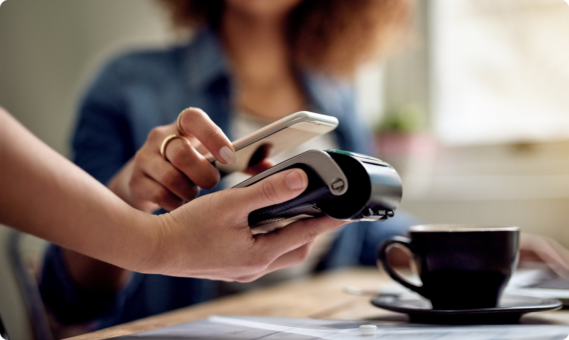
Contactless Payments

Contactless Payments
Contactless payment allows spenders to use smartphones, or even smartwatches, to pay for items, much like virtual credit cards in a digital wallet, using a contactless reader. You simply add your credit or debit card to the mobile product you have and hold your phone up to either the dedicated terminal (for retailers using NFC “near-field communication” technology) or the regular credit card terminal.
“Contactless payments exploded in popularity in spring 2020, when the coronavirus upended how many people think about paying for things. In an April survey by Mastercard of 17,000 consumers in 19 countries, 82% of respondents said they view contactless payments as ‘the cleaner way to pay.’”
Taylor Tepper, Wirecutter | New York Times
In today’s fast-paced and digital world, consumers are constantly seeking convenience, speed, and security in their payment transactions. This has led to a surge in demand for contactless payment methods, which use technology such as NFC (Near Field Communication) or QR codes to enable transactions without the need for physical contact between the payment device and the payment terminal. As a business owner, incorporating contactless payment methods into your operations can provide a range of benefits that can help to improve your bottom line. In this blog, we will explore 5 ways your business can benefit from using contactless payment methods.
Contactless payments are fast and easy. Customers can simply tap or scan their payment device and the transaction is complete. This means that checkout times can be reduced, saving your employees valuable time as they make business purchases.
With traditional payment methods, your team members may need to take out their wallets, search for cash or cards, hand them over to the cashier, wait for change, and sign receipts. This process can be time-consuming and frustrating, especially when on a tight schedule. Contactless payment methods eliminate these steps, allowing you and your team to complete transactions quickly and efficiently.
Contactless payments use advanced encryption technology to protect against fraud and theft. When a card user on your team makes a payment using a contactless payment device, the payment information is encrypted and transmitted securely to the payment processor. This ensures that the payment information cannot be intercepted or stolen by malicious actors.
Additionally, contactless payments typically have a lower risk of fraud than traditional payment methods such as cash or checks, which can be counterfeited or stolen. By offering contactless payment options, your business can provide a secure payment experience for employees.
“Both contactless and EMV chip credit cards create a unique, one-time-use code for the transaction instead of sending your name, billing address, CVV code, or zip code. This is called “tokenization.” So, even if a thief intercepted your contactless transaction, they couldn’t do much with the information.”
Maria Adams, WalletHub
By taking advantage of contactless payment options, businesses can provide their employees with a modern and convenient payment experience without the need for cash. Contactless payment methods are becoming increasingly popular among consumers and businesses alike, especially younger generations who prefer to use digital payment methods.
By adapting to these trends and offering contactless payment options, your business can improve overall card user satisfaction and encourage responsible and efficient business spending. Additionally, by providing your team with a convenient payment experience, you can reduce the likelihood of needing to use cash for business expenses. Cash payments are notoriously hard to keep track of and increase your risk of lost or misused business finances.
Contactless payments can provide businesses with valuable data on employee spending habits and help keep your books balanced and up to date. When an employee or contractor makes a payment using a contactless payment device, the payment information is recorded and can be used for analytics and reporting purposes.
Cash or personal card reimbursement can slow down your data and reporting practices and is often a headache for accountants and money managers. By utilizing contactless payments, you can get real-time insights into all business purchases being made.
In a post-Covid world health is often top of mind for many people. Contactless payments provide a touch-free payment experience, which can help to improve hygiene and reduce the spread of germs and bacteria. Traditional payment methods involve physical contact between the payment device and the payment terminal, which can potentially spread germs. By using contactless payment methods, your team can avoid touching payment terminals or exchanging cash and cards with cashiers, reducing the risk of transmission.
Incorporating contactless payment methods into your business can have a significant impact on your operations and employee experience. Whether you run a brick-and-mortar store or organize multiple job sites, contactless payments can provide a range of benefits that can help to improve your bottom line. By offering a fast, secure, and convenient payment experience, businesses can stay ahead of the competition. So why not consider utilizing this technology in your business today?